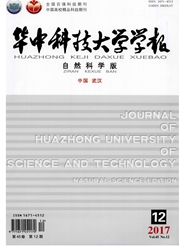

 中文摘要:
中文摘要:
采用水热晶化法制备了不同掺硼(B)量的B/TiO2,利用可见光催化降解有机污染物试验考察制备条件对其光活性的影响,得到最佳制备条件:TiCl4为钛源、氨水为碱化剂、前驱物粉体用量为65 g/L、介质pH为10、保温温度为120℃和保温时间为6 h.采用X射线衍射法(XRD)、扫描透镜(TEM)和紫外-可见反射吸收光谱对制备的催化剂进行表征.通过X-射线光电子能谱(XRS)测定活性最高的掺B/TiO2其掺B量(nB/nTi)为0.04,此时B/TiO2催化剂为金红石与锐钛矿混晶结构,其禁带宽度为2.7 eV.以酸性桃红(SRB)和2,4-二氯苯酚(2,4-DCP)的可见光降解为目标,测定SRB降解过程中总有机碳,发现SRB矿化率为42.4%.
 英文摘要:
英文摘要:
TiO2 nanoparticles doped with different content of boron was prepared by hydrothermal crystallization. The effect of synthesis conditions on the activity was researched by photo-degradation of organic pollutants under visible light. The results show that the best conditions of preparation is that the source of titanium is TiCl4, the basification is NH3 · H2O, the amount of precursor powders is 65 g/L, the value of pH is 10, the best reaction temperature and time are 120 ℃ and 6 h respectively. The B/TiO2 nanoparticles was characterized by x-ray diffraction(XRD), transmission electron microscope(TEM) and UV-vis spectra. When the best mole rate of B and Ti was 0.04 measured by the photoelectron spectroscopy (XPS), the crystal form of B/TiO2 was mixed crystal with rutile phase and anatase phase, and the band gap of B/TiO2 was 2.7 eV. The photo-catalytic degradations of sulforhodamine B(SRB) and 2, 4-dichlorophenol(2, 4-DCP) under visible light were used probe reactions to evaluate photo-catalytic activities. Total organic carbon (TOC) in the degradation process of SRB had also been measured. It indicated that the mineralization rate of SRB was 42.4%.
 同期刊论文项目
同期刊论文项目
 同项目期刊论文
同项目期刊论文
 Development and validation of a hydrophilic interaction liquid chromatographic method for determinat
Development and validation of a hydrophilic interaction liquid chromatographic method for determinat Preparation of CdS nanoparticles with reverse micelle method and photo-degradation of malachite cree
Preparation of CdS nanoparticles with reverse micelle method and photo-degradation of malachite cree 期刊信息
期刊信息
